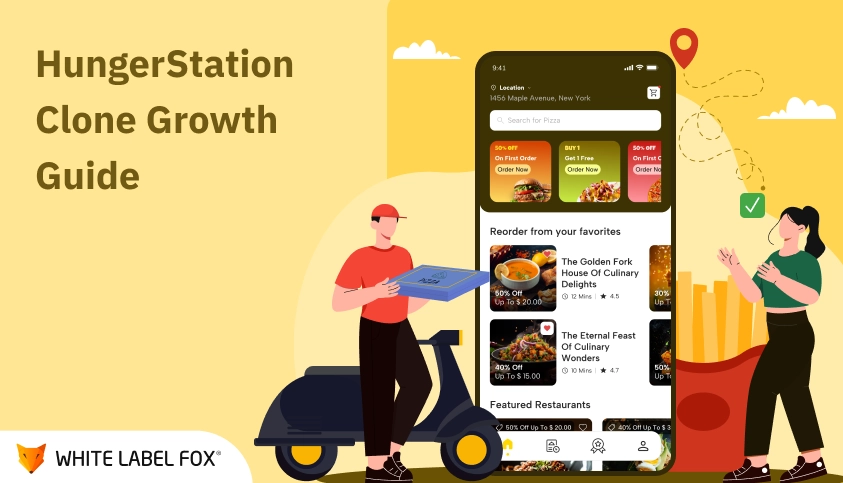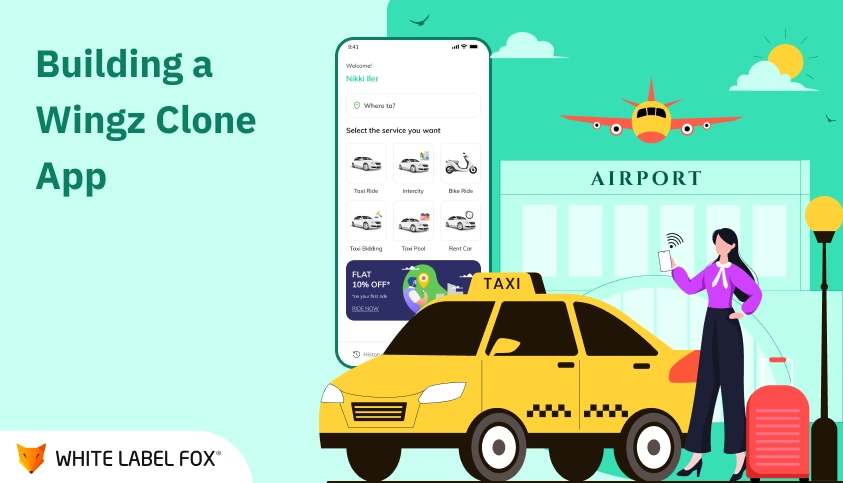In the last ten years, the ride-hailing business has utterly changed city transportation all over the world. A revolutionary concept, once a tap on your phone to call up a taxi, has become a daily habit for tens of millions. Companies like Uber, Lyft, and Ola have shown the world that the ride-hailing business is a scalable and profitable business.
The ride-hailing service industry is anticipated to reach $381.3 billion in 2033. If you're set to take on this profitable territory, here's the catch: You don't have to begin from scratch. With taxi clone apps, particularly Uber clone solutions, entrepreneurs can now accelerate their entry into the marketplace, save a lot of development time, and cut their go-to-market expenses immensely.
In this blog, we will see how to begin your ride-hailing company, select the correct Uber clone app, develop a successful business model, and onboard users effectively.If you are a startup entrepreneur, a transportation firm eager to take your business online, or an investor seeking scalable app-based services, this is your roadmap to success.
Why Opt for an Uber Clone App to Begin Your Taxi Business?
When you hear about the Uber clone, you may think of a cheap imitation. But in fact, a properly developed Uber clone is a robust, feature-complete, highly customizable solution offering 80-90% of what you require to start your own ride-hailing platform, at a fraction of the price and time of custom development.
Curious about market leaders? Check out the best ride-hailing apps in Malaysia to understand what your Uber-like app is competing against.
Advantages of Selecting a Taxi Clone App
Quicker Time to Market: It may take 9–12 months to develop a complex app such as Uber from the ground up. An Uber clone app from a trusted provider such as White Label Fox can get you up and running within less than a month.
- Successful Business Logic: Clone apps are designed using proven models, meaning less bugs, fewer pivots, and greater stability from day one.
- Customizability: The latest taxi clone solutions are white-label, and you can rebrand them using your logo, design, and features to differentiate yourself in your local market.
- Cost Efficiency: It can cost ₹20–₹50 lakhs or more for custom app development. A clone app with the core features and customization can be much cheaper, making it a good fit for startups with tight budgets.
What to Look for in a Taxi Clone App?
Not all clone apps are the same. Here's what to look for in a solid solution:
- Dual rider and driver mobile apps
- Live GPS tracking and route optimization
- Secure payment gateway (cards, wallets, UPI)
- Admin panel for analytics, commissions, and management
- Driver ratings, reviews, and earnings summary
- Multilingual and multi-currency support for scalability
White Label Fox's Uber Clone App features all of these basics—plus choices for add-on modules such as carpooling, rental rides, or outstation booking.
Market Research for Your Ride-Hailing Company
It is important to perform thorough market research before you start your app. This process prevents you from making expensive errors, makes your app suitable for local requirements, and finds untapped markets.
Find Your Target Market
Ask yourself these:
- Are you catering to Tier-1 high-competition cities or Tier-2/3 regions where there is unserved demand?
- What are the transport issues in your desired location (e.g., expensive fares, bad public transport, scarce taxis)?
- What are the underserved segments—gals-only cabs, business rides, green cabs?
With this knowledge, you can establish your distinctive selling proposition (USP) and create a more pertinent, niche-friendly ride-hailing app.
Analyze the Competition
Examine what current players in your area are doing:
- What are their strengths and weaknesses?
- Are their apps easy to use?
- How do they price their services?
Your mission isn't to replicate them—it's to create the gaps they're leaving open.
Learn Local Laws & Compliance
Ride-hailing is governed by local transportation legislation, licensing, and occasionally unionized labor laws. Before taking off:
- See if there are specific permits or deals needed with city councils.
- Find out about insurance on drivers and vehicles.
- Keep current with safety standards such as panic buttons, background checks, and data policies.
Launch Your Ride-Hailing Business in Just 7 Days!
Book a free consultation and discover how our customizable Uber Clone App can take you from idea to market-ready in record time.

How to Design a Lucrative Business Model?
A great app by itself won't make money. You must have a successful business model that is compatible with your market, margins, and scalability aspirations. Let's dissect the main revenue streams and monetization models for your taxi company.
Ride-Hailing Business Revenue Streams
Commission-Based Model
- You charge a set % commission per ride (e.g., 15–25%).
- This is the most prevalent model employed by Uber, Lyft, and Ola.
Driver Subscription Model
- Drivers pay a weekly or monthly subscription to utilize your platform.
- Predictable revenue is guaranteed in such areas with a steady driver base.
Passenger Convenience Fee
- Implement a small charge for app usage, particularly on premium services such as luxurious rides or rush-hour bookings.
Surge Pricing & Dynamic Fares
- Implement automatic fare hikes during peak-demand times (weekends, rainy days, events).
In-App Advertisements
- Generate revenue through advertisements displayed to passengers during booking or waiting time.
Corporate Tie-ups
- Provide B2B ride-hailing services to companies and bill them monthly or per-ride.
Tips on Profit Optimization
- Employ real-time analytics to dynamically modify commissions and incentives.
- Offer bundled packages for customers (e.g., 10 rides/month for a fixed price).
- Operate driver loyalty programs to prevent churn.
Key Features Your Taxi Clone App Should Incorporate
To match the giant companies and provide an optimal user interface experience, your Uber clone app should be feature-based, user-friendly, and optimized for real-time activity. Here is an overview of the key features you should include across all panels.
Features of the Passenger App
- One-Tap Booking: Enable users to book a ride easily with pre-saved addresses and location auto-detect.
- Multiple Payment Modes: UPI, credit/debit cards, wallets, and even cash.
- Real-Time Ride Tracking: GPS-based tracking so users can view their ride in progress.
- Fare Estimates: Correct pricing displayed prior to booking.
- Schedule a Ride: Allow users to pre-book rides for a date & time in future.
- SOS Button: Critical for safety—call local authorities or emergency contacts.
- Ratings & Reviews: Passengers can review and rate drivers.
Want to explore more features? Read more about our Uber Clone App features to see how we can help you launch your ride-hailing business successfully.
Driver App Features
- Trip Requests with Directions: Instant ride requests and GPS-directed route recommendations.
- Earnings Dashboard: Live earnings, tips, and ride history.
- Online/Offline Mode: Drivers have the option to turn availability on or off according to personal timetables.
- Ratings & Feedback: Ensures better service quality and safety.
Admin Panel Features
- Driver & Passenger Management: Easily approve, block, or track users.
- Commission and Payout Settings: Customize commissions, monitor payments, and manage settlements.
- Zone Management: Define operating zones, surge zone pricing, or city-based rates.
- Analytics Dashboard: Track KPIs such as successful rides, cancellations, revenue, and app usage.
- Promo Code Management: Run referral or discount promotions to acquire and retain users.
Legal Considerations and Regulatory Compliance
Launching a ride-hailing company involves more than just code and users—you must also comply with government rules, keep user information private, and maintain platform security.
Business Registration & Licensing
Register your business as a legal entity (LLP, Pvt Ltd, etc.) first. Then, confirm compliance with your city or state's transportation licensing process. Depending on where you are, you might need:
- Ride aggregator licenses (popular in India)
- Local transportation permits
- Commercial vehicle insurance documents
Make sure all drivers you onboard also possess the necessary commercial driving licenses.
Data Privacy and Security
Processing real-time location data, payment details, and personal data means you're subject to data privacy legislation such as:
- GDPR (EU)
- DPDP Act (India)
- CCPA (California)
Ensure your platform adheres to data encryption practices, provides consent management, and keeps data secure. Your privacy policy and terms of use should specifically detail how user data is processed.
Safety Measures
After the pandemic, safety matters most. Make sure:
- Driver background checks
- Forced SOS buttons in-app
- Contactless payment
- Mask policies or hygiene protocols, if required
Being compliant not only safeguards you legally but also increases customer trust and satisfaction.
User Acquisition Strategies for Your Taxi App
A good product requires a good launch. Once your app is launched, the next problem is to get drivers and passengers. Here's how:
Open with a Driver-First Strategy
- Targeted ads or WhatsApp promos for local drivers.
- Sign-up incentives (₹500–₹1000) for finishing their first 5–10 trips.
- Host driver onboarding sessions within local communities or transport points.
- Reward loyalty benefits such as reduced commission for early birds.
Passenger Acquisition Tactics
- Provide first-trip-free or ₹50 discount promo codes.
- Offer referral campaigns (₹100 reward for each friend referred).
- Partner with apartment communities, schools, or workplaces to promote app downloads.
- Use hyperlocal social media advertising with city-focused messaging.
- QR codes can also be utilized in high-traffic areas (bus stops, cafes, parking lots) to push installs.
Retention is the Real Game
It's one thing to acquire users, but retaining both drivers and riders is key to long-term profitability.
- Develop gamified rewards for high-performing drivers.
- Send targeted push notifications with offers, ETA reminders, and new feature releases.
- Execute city- or festival-based offers (e.g., offers during Diwali, New Year, etc.).
- Implement subscription plans for heavy users (e.g., 10 rides/month for ₹599).
With a combined dashboard from White Label Fox, you can automate a lot of your user interactions, track patterns in behavior, and optimize your campaigns.
Scaling and Monetizing Your Ride-Hailing App
After your ride-hailing business goes live, the actual work starts: scaling operations and maximizing revenue. It's not about launching a profitable business model — it's about growing healthily, optimizing operational efficiency, and winning a loyal user base while unlocking multiple revenue streams.
A. Streamline and Optimize Operations
To facilitate scalability:
- Invest in Scalable Infrastructure: Cloud-based hosting ensures that your app manages increasing user traffic without performance lags.
- Automated Dispatch: Employ smart algorithms to match riders with drivers based on location, driver ratings, or route preferences.
- Driver Onboarding Workflow: Efficiently onboard your drivers through video modules and auto-document verification.
B. Diversify Services for Broader Reach
Providing differentiated transportation services boosts market share and fulfills varied customer needs:
- Car Categories: Economy, Premium, Executive, SUV, and Electric Vehicles.
- Bike and Scooter Rides: Suits dense traffic urban areas with small travel distances.
- Rental Services: Provide one-day or one-hour vehicle rentals for business professionals or tourists.
- Outstation and Intercity Travel: Cater to intercity travel by providing fixed-priced rides on the most common routes.
- Corporate Rides: Provide month-end billing, employee ride history tracking, and priority booking for companies.
C. Strong Monetization Models
You don't have to depend on commission per ride only. A hybrid monetization model yields greater income potential and long-term growth:
- Commission on Rides: The traditional model, where you take a percentage (e.g., 15–25%) of every trip fare.
- Driver Subscription Plans: Provide weekly/monthly subscription plans to drivers in return for zero commission or enhanced benefits.
- Peak-Time Pricing: Raise fares for high-demand periods (rainy days, weekends, holidays).
- In-App Promotions: Enable local businesses to display ads or sponsored promotions in your app.
- Delivery Services: Leverage your fleet for food or parcel delivery services when there is low demand for rides.
D. Take Advantage of Data and Analytics
Data is everything for growth. Leverage analytics for:
- Understanding customer behavior.
- Optimizing price and route recommendations.
- Predicting demand from historical trends.
- Minimizing churn by identifying and fixing frequent grievances.
E. Driver-First Strategy
A happy and loyal driver community is the key to operational stability. Provide:
- Performance incentives.
- Fuel rebates and car maintenance assistance.
- Onboarding referral bonuses for new drivers.
- Live support through chat or call centers.
Scaling successfully involves getting the balance between quality service, deep brand presence, and driver happiness while testing different monetization models that suit your market's expectations.
Closing Thoughts
Creating a ride-hailing company may appear to be a grand undertaking, but with the appropriate strategy, resources, and market knowledge, it's one of the most viable businesses in the digital mobility sector today.
Let's summarize the major takeaways:
Ride-Hailing Is an Evergreen Demand Market
- Mobility is a necessity, not a luxury — particularly in expanding urban spaces.
- Individuals desire convenience, safety, and affordability of mobility, and technology-based solutions provide precisely that.
- With smartphones today common in Tier-1 and Tier-2 cities, new entrants are ready to ride the wave.
Your App is the Core of the Business
- A working, user-friendly, and scalable ride-hailing app is not a choice — it's a requirement.
- From effortless ride booking and real-time driver location to alternative payment methods and SOS functionality, your app needs to provide a fantastic user and driver experience.
Execution Trumps Ideas
- You don't require a new idea.
- What you require is correct implementation — from good market research, a proven business model, local driver onboarding, a launch plan, and intense focus on user acquisition.
Internal Resources and Support Matter
- If you want to seriously start a successful ride-hailing business, you'll require more than an application.
- Consider customer support infrastructure, local regulations management, driver dealing processes, and regular technology updates.
- Fortunately, White Label Fox does not leave you with just the app — we deliver complete support, ranging from customization to post-launch updates.
Get Your Queries Solved
- One-tap ride booking
- Live GPS tracking
- Fare estimation
- SOS/emergency button
- Multiple payment options
For drivers:
- Route optimization
- Earnings dashboard
- Trip history
Admin panel essentials:
- Zone-based pricing
- Real-time analytics
- Commission and payout management
White Label Fox’s ride-hailing app solution comes with all these features pre-configured and is fully customizable.
- Company registration (LLP/Pvt Ltd)
- Aggregator license under the Motor Vehicles Act
- Commercial vehicle insurance
- Driver verification (police clearance, DL)
- Regional transport permits
State-wise requirements vary, so consult with legal counsel. Apps must also comply with data privacy laws like the DPDP Act. White Label Fox’s platform includes built-in safety and compliance features.
For drivers:
- Run referral bonuses
- Offer guaranteed earnings for first week
- Reduce commissions temporarily
For passengers:
- First-ride-free or flat discount offers
- Local influencer promotions
- QR code posters in high-traffic areas
- Partnerships with residential societies and office parks
Use targeted digital ads and app store optimization (ASO) to drive installs. Track all campaigns using analytics dashboards, a feature available in White Label Fox’s admin panel.
Common pitfalls include:
- Ignoring regulatory requirements
- Launching without driver supply
- Skipping competitive analysis
- Overloading the app with features at MVP stage
- Poor customer support infrastructure
Avoid these by validating your market, launching lean, and partnering with a reliable app provider like White Label Fox. Their clone solution allows you to focus on growth instead of worrying about tech development and post-launch updates.
Would you like these FAQs delivered as a separate .docx file or directly embedded into your blog format for publishing?

















